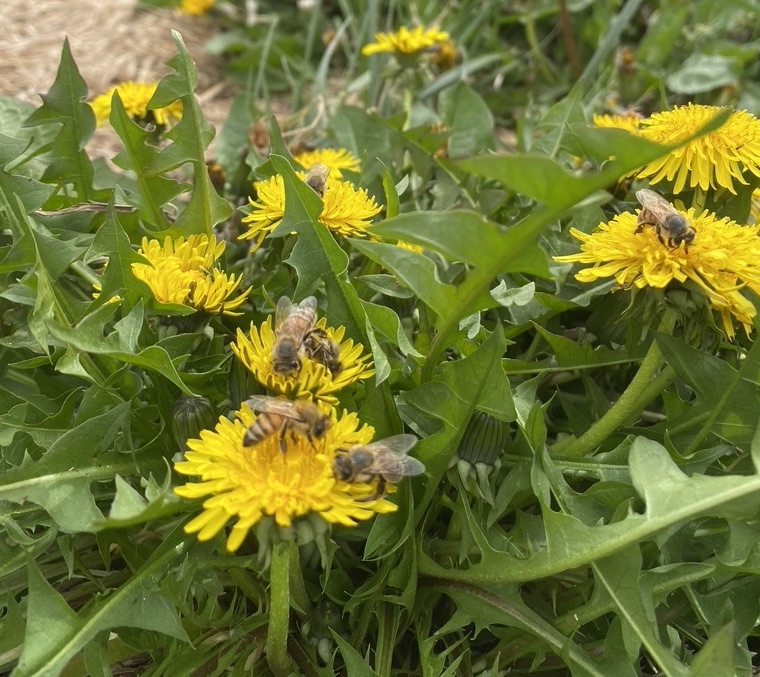Spring Feeding: How and When Should I Feed My Bees?
- Posted on
- By Amber Shehan
- Posted in bee, beekeeper's year, beekeeping, dearth, feeding, seasonal beekeeping, seasons, spring, sugar syrup
- 2

Early spring can be a tricky time for beekeepers as they decide whether or not to support their hives with extra feeding. If you are establishing new colonies or if weather conditions are making it hard for your bees to forage, supplementing with sugar syrup can offer additional sustenance for your bees.
Feeding has its downsides, as it can encourage robbing, drowning, or increase humidity in the hive. Also, sugar syrup doesn't offer a lot of nutrients.
Why feed bees in spring?
During the colder winter months, bees survive on stored honey and pollen gathered from the previous year. Our early bees require a lot of food because they have many tasks ahead of them like raising brood, foraging, and constructing comb for their home. Pollen has a ton of protein in it which our nurse bees use to make bee bread for young, healthy bees.
Feeding New Bees
We always recommend feeding your new bees whether they come from a nuc, a package, or a swarm. Feeding is essential in your first year because our bees rely on their food sources to create their homes and start storing food for the dearth periods. Supplemental feeding doesn’t need to last forever. Most beekeepers find that their honeybees prefer true nectar to the artificial source we provide. Once your bees stop drinking as much sugar syrup, you can stop supplemental feeding.
If you find that the weather is going to turn - for example, if we’re going to have a prolonged period of cold or rain - you might need to start providing sugar syrup to your bees again.
What do I feed my bees?
Share extra honey frames from super strong colonies with weaker hives. Play Robin Hood and steal from the rich and give to the poor! If you plan to add frames from another hive, make sure you utilize frames from the same bee yard. Otherwise, you could be introducing pathogens from outside yards!
Crystallized honeycomb might not appeal to us, but it does not bother the bees.
Sugar syrup is one of the most common ways to supplement bees in early spring. Make a 1:1 sugar-to-water syrup with pure cane sugar. Avoid beet sugar because it can cause an illness in the bees called nosema - basically, bee dysentery. Most local brands (ie: Aldi, Walmart, Ingles) carry pure cane sugar. It is always a good idea to double-check by calling the number on the package and asking!
Don't forget about pollen! Honey bees require a balance of nutrients in their diets, especially in early spring when there is a lot of brood production. Pollen provides protein and nutrition for busy hives.
You can also use high-protein supplements to help out bees in spring. We recommend Honey-B-Healthy or HiveAlive. Both are proprietary blends of essential oils that coat the lining of the bee’s digestive tract to help prevent nosema. They also both are feeding stimulants so your bees can find the supplemental feed faster. HiveAlive has peer-reviewed research here that you can check out.
How do I feed my bees?
We have many feeder options for bees in stock!
Boardman, or entrance feeders, are usually not the best option for early spring feeding, as bees have to break their cluster during cold days to get to the syrup. Entrance feeders can also promote robbing from bees outside of the colony. Instead, try feeding inside the hive.
Double jar feeders are popular because they sit inside the hive, which lowers the chance of robbing, drowning, and making a mess. Division board feeders are another option for getting the syrup near the bees. Our most popular feeders are hive-top feeders. Most of them can be used for multiple seasons (feeding with liquid or solid sugar) and are convenient to check on and refill.
The most inexpensive method of syrup feeding is using a plastic bag. Simply place a plastic zip-lock sandwich bag filled with syrup on the top bars. A slit is sliced into the top layer of the bag so that bees can access the syrup. You will need a shim or an extra box to give the bag a bit more space, but it is a great low-cost solution if you’re in a pinch.
How do I prepare for next Spring?
Next time, try to leave more honey for the bees. Ideally, hives will have at least one medium super full of honey (if not more!). They spend all spring and summer working to have enough to survive through winter, and their own honey is their ideal food. Harvest less honey, and if you are starting a new hive, we encourage you to leave the bees all of their honey during the colony’s first year.

Hey Missi! If the daily temperature is at least 55 degrees and it is sunny, open up the hive and check them out. If it is too cold, do a heft test and guess the weight.
If you need to feed, you can try to feed with fondant, candy board, or sugar because it might be too cold to feed with syrup. I'm not sure where you are located, but around here in Weaverville, we are still having some very cold temps at night.
I hope that helps!
I left two medium supers full of honey on each of my 5 hives. All have survived the winter and appear to have begun raising spring brood. On sunny days in mid-February there was lots of flying and bringing in pollen. How quickly will the bees eat up the honey that I left on last fall? Is there any way to know whether I should be supplementing with sugar from now until the big leaf maples bloom in mid-April?